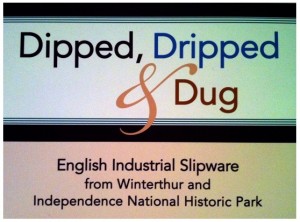Dipped, Dripped & Dug: English Industrial Slipware (NCC Site Archaeology on Exhibit)
Back to Index of Exhibits…
Review Article for PAF: English Industrial Slipware from Winterthur & Independence National Historical Park on view through Fall 2011-mid-2012. Ceramics and Glass Gallery, Museum Galleries Building, Winterthur Museum

Don’t miss this gorgeous and informative exhibit featuring artifacts excavated from the site of the National Constitution Center in Independence National Historical Park (INHP NCC). This exhibit explores the world of English Industrial Slipware — a middle-priced ceramic commodity in use circa 1780-1850. Commonly referred to as ‘mocha’ and ‘dipped’ (but also known archaeologically as ‘annular’ and ‘banded’)* these ceramics are ubiquitous on early- to mid-19th century U.S. historical archaeology sites. A particularly large assemblage of such wares was recovered at the site of the site of the NCC. This current exhibit presents these Independence Park archaeological remains alongside heirloom objects that made their way into the Winterthur collections.

Taken together, these below- and above-ground ‘data sets’ demonstrate the dramatic range of bold decorative styles found on these period cups, bowls, mugs, and pitchers. The text accompanying the exhibition conveniently provides some technological discussion about this type of ceramic decoration and also presents some social context for the objects. But this display is also archaeological eye-candy! The viewer can’t help but marvel at the delightful decorations on the individual vessels, which appear all the more strikingly as a collection grouped in an exceptionally artistic arrangement.
Speaking as an historical archaeologist, it is wonderful to see the INHP NCC ceramic evidence incorporated so effectively into this rich material culture display. This Winterthur exhibit offers the historical archaeologist a good opportunity to see a very wide range of mocha/dipped (annular/banded)* decoration via a sample of specimens comprised of more than just fragments. Moreover, with the designs of the surviving Winterthur pieces added in, the range of patterns on display likely surpasses any archaeologist’s reference type collection — one more reason to not miss this exhibit.
The dates for this exhibit are not listed anywhere that I could find. These objects have already been on display for several months at this point. Therefore, if you are thinking of going to see this exhibit it might be best to go sooner rather than later. You will find this display of approximately 50 items (whole and partial vessels) in the Ceramics and Glass Gallery in the Winterthur Museum Galleries Building. Payment of the Winterthur entrance fee is required.
* Period documents indicate that the manufacturers of these decorated wares, as well as many period wholesalers and retailers, used the terms ‘mocha’ and ‘dipped’ in describing them. These terms are commonly used in today’s antique’s trade, the decorative arts and material culture studies worlds, and in historical archaeology. This style of decoration is also otherwise long-known to historical archaeologists as ‘annular’ and ‘banded’ decoration. Historical archaeologists focusing on the consumers of such goods (as opposed to the producers/manufacturers) sometimes seek the customer’s understandings, or ‘categories of thought’, about such material items. Non-manufacturer-based typologies can reveal important cultural insights related to issues of ethnic identity, class, social status, and gender.

For more information….
— National Constitution Center Archeology Site (Independence National Historical Park)
— Annularware, Banded Decoration Type Index (Historical Archaeology at the Florida Museum of Natural History)
Patrice L. Jeppson, Ph.D.
June 30, 2011
by admin